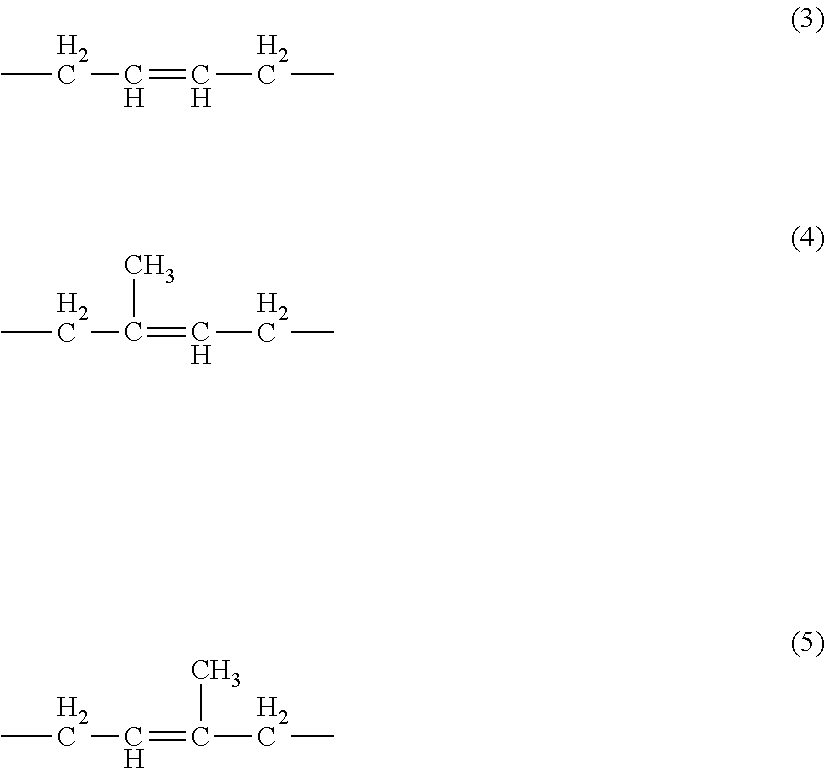Modified conjugated diene polymer, modified conjugated diene polymer composition, tire, and method for producing modified conjugated diene polymer
a conjugated diene polymer and polymer technology, applied in the field of modified conjugated diene polymer composition, etc., can solve the problems of low affinity for conjugated diene rubber, poor dispersibility, and disadvantages of silicone, and achieve low hysteresis loss, good abrasion resistance, and good abrasion resistance
- Summary
- Abstract
- Description
- Claims
- Application Information
AI Technical Summary
Benefits of technology
Problems solved by technology
Method used
Image
Examples
example 1
[0449]Into a temperature-controllable autoclave having 40 L inner volume equipped with a stirrer and a jacket used as a reactor, 2,220 g of 1,3-butadiene, 780 g of styrene, 21,000 g of cyclohexane, and polar substances consisting of 2 g of tetrahydrofuran (THF), 4.73 g of 2,2-bis(2-oxolanyl)propane (BOP), and 2.81 g of piperidine (Pip) were loaded, where impurities had been removed from the materials in advance, and the inner temperature of the reactor was retained at 43° C.
[0450]Further, 2.01 g of n-butyllithium as a polymerization initiator was fed to the reactor.
[0451]After the initiation of polymerization reaction, the temperature in the reactor began to elevate through heat generation due to polymerization, and ultimately reached 74° C.
[0452]Two minutes after the reaction temperature reached the peak, 1.42 g of tristrimethoxysilylpropylamine (Cup-4) was added to the reactor, and 2 minutes thereafter 1.91 g of 3-(4-methylpiperazin-1-yl)propyltriethoxysilane (Cup-2) was further a...
example 2
[0456]Into a temperature-controllable autoclave of 40 L inner volume equipped with a stirrer and a jacket used as a reactor, 2,220 g of 1,3-butadiene, 780 g of styrene, 21,000 g of cyclohexane, and polar substances consisting of 2 g of tetrahydrofuran (THF), 4.73 g of 2,2-bis(2-oxolanyl)propane (BOP), and 2.81 g of piperidine (Pip) were loaded, where impurities had been removed from the materials in advance, and the inner temperature of the reactor was retained at 43° C.
[0457]Further, 2.01 g of n-butyllithium as a polymerization initiator was fed to the reactor.
[0458]After the initiation of polymerization reaction, the temperature in the reactor began to elevate through heat generation due to polymerization, and ultimately reached 76° C.
[0459]Two minutes after the reaction temperature reached the peak, 0.95 g of tristrimethoxysilylpropylamine was added to the reactor, and 2 minutes thereafter 2.67 g of 3-(4-methylpiperazin-1-yl)propyltriethoxysilane was further added thereto, and th...
example 3
[0464]Into a temperature-controllable autoclave of 40 L inner volume equipped with a stirrer and a jacket used as a reactor, 2,220 g of 1,3-butadiene, 780 g of styrene, 21,000 g of cyclohexane, and polar substances consisting of 2 g of tetrahydrofuran (THF), 4.73 g of 2,2-bis(2-oxolanyl)propane (BOP), and 2.81 g of piperidine (Pip) were loaded, where impurities had been removed from the materials in advance, and the inner temperature of the reactor was retained at 44° C.
[0465]Further, 2.01 g of n-butyllithium as a polymerization initiator was fed to the reactor.
[0466]After the initiation of polymerization reaction, the temperature in the reactor began to elevate through heat generation due to polymerization, and ultimately reached 76° C.
[0467]Two minutes after the reaction temperature reached the peak, 0.47 g of tristrimethoxysilylpropylamine was added to the reactor, and 2 minutes thereafter 3.43 g of 3-(4-methylpiperazin-1-yl)propyltriethoxysilane was further added thereto, and th...
PUM
| Property | Measurement | Unit |
|---|---|---|
| molecular weight distribution | aaaaa | aaaaa |
| molecular weight distribution | aaaaa | aaaaa |
| molecular weight distribution | aaaaa | aaaaa |
Abstract
Description
Claims
Application Information
 Login to View More
Login to View More - R&D
- Intellectual Property
- Life Sciences
- Materials
- Tech Scout
- Unparalleled Data Quality
- Higher Quality Content
- 60% Fewer Hallucinations
Browse by: Latest US Patents, China's latest patents, Technical Efficacy Thesaurus, Application Domain, Technology Topic, Popular Technical Reports.
© 2025 PatSnap. All rights reserved.Legal|Privacy policy|Modern Slavery Act Transparency Statement|Sitemap|About US| Contact US: help@patsnap.com



